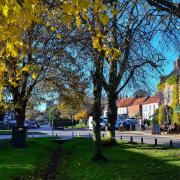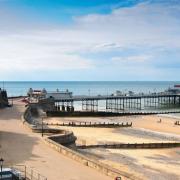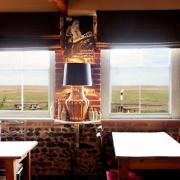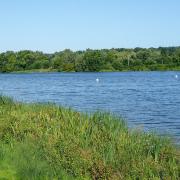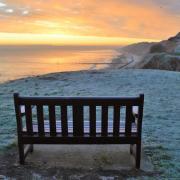Go west – and find a watery landscape which harbours some of Norfolk’s most thrilling history and wildlife.
All Aboard!
Well bust my buffers, the Thomas the Tank Engine stories were written by a Norfolk reverend. Wilbert Awdry wrote 11 of the world-famous books while Vicar of Emneth, near Wisbech, between 1953 and 1965. He originally wrote them for his children and up in the attics of Emneth Vicarage he also created a complicated model railway layout. The nearby Wisbech and Upwell tramway was the inspiration for Toby the Tram Engine and his coach, Henrietta. At the time Emneth had its own railway station, and the vicar was part of the unsuccessful campaign to save the line from the Beeching cuts. Wilbert died in 1997 and is remembered in a stained glass window at St Edmund’s church, Emneth.

Ancient Music
Villages tend to come in clusters on the western edge of Norfolk. Many, like the Walpoles and Waltons, begin with ‘wal’ from flood defence walls which date back to Roman times. More than 1,000 years later the rich Fenland soil made some of these villages very rich indeed and much of that wealth was lavished on vast and beautiful churches. The medieval church at Walpole St Peter has been called the best parish church in the country. It is a treasury of soaring architecture and glowing paintings. The village was also the birthplace of a saint. St Godric is described in Peter Tolhurst’s book Norfolk Parish Treasures as a “pedlar, pirate and pilgrim.” Born in the 11th century he was also renowned as a vegetarian animal lover, advisor to both Thomas Becket and Pope Alexander III, and a songwriter. Four of his hymns are the oldest in English for which the original musical settings still survive.

Judged Poorly
Wallington Hall was once the home of a judge so hated that when he died several parishes refused to bury him and his decomposing corpse ended up being covered by stones at North Runcton. Judge Francis Gawdy opened the prosecution case against tragic Mary, Queen of Scots in 1586 and was a member of the court which condemned Sir Walter Raleigh to death in 1603. He inherited Wallington through his wife, Elizabeth, and set about creating parkland around it – demolishing Wallington village, between South Runcton and Stow Bardolph, including most of the church, leaving only the tower to become a hay loft and kennel for his dogs. He cheated his wife out of another inheritance from her father and rumours of treasured buried in the park swirled for centuries. He is recorded as dying of apoplexy and poor Elizabeth died after locking herself in a room to escape a local uprising.
The estate is a much happier place today and the base for West Norfolk Riding for the Disabled for more than 30 years, with lessons in the indoor riding school and outdoor hacks and carriage drives along the beautiful tracks through the parkland.
Terrific Tulips
The tulip fields of the Netherlands are world famous – but West Norfolk has its own colourful displays. Belmont Nurseries of Terrington St Clement is the UK’s largest commercial grower of outdoor tulips. It also supplies the largest supermarkets in the UK with freshly cut daffodils, peonies, sweet williams, gladioli and more. Every spring west Norfolk fields are transformed into dazzling geometric pictures as the bulbs bloom.

Giants vs Ogres
A giant once lived here. The story of mighty Tom Hickathrift, who vanquished an ogre, is probably based on a real person – perhaps originally a Saxon fighting the Norman invaders. Stories of his exploits have been told for centuries, although the first known written account dates back to 1631. He features on the village sign at Marshland St James and his grave is inside All Saints Church in Tilney All Saints. Tom was outlandishly tall and strong and fought his enemy, or an ogre in some versions, using a cart wheel as a shield and an axle as a sword. In the 1631 story his job, travelling between King’s Lynn and Wisbech for a brewery, was made difficult by a man-eating ogre in the marshes. Tired of long detours Tom decided to cut across the ogre’s land – and emerged the winner when challenged to a fight.
There are more tales of Tom choosing where to be buried by hurling a stone boulder and even separating the tower from the church at West Walton (which remains separate to this day!) He was none too careful around churches as he is also blamed for damaging at Walpole St Peter’s church during a game of football with the devil.

Out on the Ice
Some of England’s greatest ice skaters lived in the villages of the westernmost fringes of Norfolk. Climate change means few winters are now cold enough to skate but in past centuries villagers gathered to skate, to race and to play bandy – the precursor of ice hockey – as the shallow water flooding fenland fields froze. Skating races were held here for hundreds, if not thousands, of years but were particularly popular in the 19th century with exotically-named stars including Larman Register, Gutta Percha See, Fish Smart and his father Turkey.
An Unusual Request
A wax effigy is a startling, and disconcerting, memorial to Stow Bardolph woman Sarah Hare who died of blood poisoning, aged 55, in 1744 after pricking her finger while sewing. There were whispers that it was punishment for sewing on a Sunday. Her will asked that her face and hands should be modelled in wax and, dressed in a wig and red satin, placed in a glass case in the family mausoleum in Stow Bardolph Church. She is still there, surrounded by elaborate monuments to her relatives, part Sleeping Beauty, part Snow White, part a literally warts-and-all likeness, and possibly England’s only funeral wax effigy outside Westminster Abbey.

Wonderous Waterways
The sluice at Denver provides a crucial barrier against the North Sea - controlling the flow of water in and out of the surrounding fens. Officially called the Denver Complex it is the biggest combination of sluices in the country, with five rivers and channels meeting here. The water is managed for navigation, conservation, agriculture, fisheries and drainage and can be redirected to reservoirs in Essex via a remarkable system which reverses a channel’s flow.
Wild Wetlands
Britain’s largest area of seasonally-flooded land is looked after by Welney Wetland Centre. It is the setting for spectacular mass gatherings of swans, geese and ducks every winter and also a little-known avian love story. Pairs of black-tailed godwits mate for life, but meet just once a year, at the spot where they first got together. They nest, lay and hatch eggs and then the female leaves while the male stays on to feed the hatchlings until they can fend for themselves. The parent godwits might range, separately, as far as Africa before returning to Welney the following spring to raise their next brood. Almost half of Europe’s black-tailed godwits have disappeared in the last 25 years as wetlands are drained but at Welney areas are being set aside for the birds, with extra help for them to continue their long-distance, long-term love stories.







